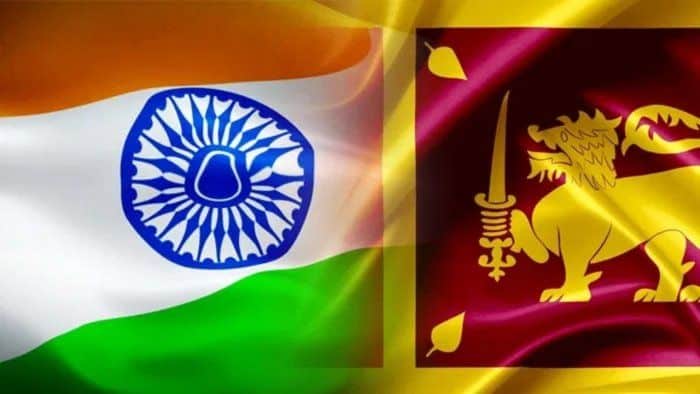What are the historical ties between India and Sri Lanka?
India and Sri Lanka have a long and complex history of cultural, economic, and political ties dating back over 2,500 years.
- Buddhism was introduced to Sri Lanka by Emperor Ashoka's son Mahinda in the 3rd century BCE. This led to the establishment of a strong cultural and religious connection between the two countries.
- In the 10th century CE, the Chola dynasty of South India conquered Sri Lanka several times. However, the Cholas also left a lasting cultural impact on Sri Lanka, influencing art, architecture, and language.
- India and Sri Lanka gained independence from British rule in 1947 and 1948, respectively. India played an important role in helping Sri Lanka establish its democratic institutions.
- Liberation Tigers of Tamil Eelam (LTTE) was formed in 1976 and it was involved in an armed conflict with Sri Lankan armed forces from 1983 to 2009.
- During the Tamil conflict, India and Sri Lanka signed the 1987 India-Sri Lanka Agreement to enact the 13th amendment and send the Indian Peace Keeping Force (IPKF) to Sri Lanka.
- The assassination of former Prime Minister Rajiv Gandhi in 1991 further changed India’s attitude towards the ethnic conflict in Sri Lanka.
- The Civil War in Sri Lanka ended through a military operation in 2009.
What is the significance of Sri Lanka to India?
Sri Lanka is of significant importance to India in various ways:
- Strategic location: Sri Lanka's location in the Indian Ocean region makes it a strategically important hub for India's security interests.
- Military significance: Sri Lanka is strategically important to India's navy, as the switching of naval fleets from the Bay of Bengal to the Arabian Sea and vice versa have to take a round of Sri Lanka.
- Economic ties: India is one of Sri Lanka's key trading partners and both countries have strong economic ties. In 2020, India was Sri Lanka’s 2nd largest trading partner, with the bilateral merchandise trade amounting to about USD $ 3.6 billion.
- Geopolitical importance: Sri Lanka's location makes it important for India's Indian Ocean strategy and for networking with partners for its aim of establishing an Indian Ocean Rim Community.
- China's presence: India is also concerned about China's increasing presence in Sri Lanka through investments in ports, which could potentially be used for military purposes.
How is India engaging with Sri Lanka in various fields?
India has been engaging with Sri Lanka in a variety of fields, including
- Economic cooperation
- India-Sri Lanka Free Trade Agreement (ISFTA) in 2000 contributed significantly towards the expansion of trade between the two countries.
- Sri Lanka is one of India’s largest trading partners among the SAARC countries. India, in turn, is Sri Lanka’s largest trade partner globally.
- Cultural relations
- Buddhism is one of the strong pillars connecting both nations. Both countries jointly commemorated the 2600th year of Buddha’s enlightenment.
- The Cultural Cooperation Agreement signed (1977) forms the basis for periodic Cultural Exchange Programmes between the two countries.
- Indian Cultural Centre in Colombo actively promotes awareness of Indian culture by offering classes in Indian music, dance, and Hindi. It also organizes the International yoga day event annually.
- India-Sri Lanka Foundation was set up in 1998 to enhance scientific, technical, educational, and cultural cooperation through civil society exchanges
- Development cooperation
- Sri Lanka is a major recipient of development assistance from the Government of India. India’s overall commitment stands close to US$ 3 billion, out of which around US$ 560 million are purely in grants.
- Indian Housing Project,commitment to build 50,000 houses for the war affected as well as the estate workers in the plantation areas. In 2017, PM signed an agreement to commence construction of 10,000 additional houses.
- The aid package includes funding for electricity power projects and north-south railway development.
- India continues to assist in a large number of High Impact Community Development Projects In areas of education, ambulance services all over the island, small and medium enterprise development, and training.
- Defence and security cooperation
- Since 2012, India has participated in the Indo-Sri Lankan Defence Dialogue. This platform helps to review security and defense cooperation issues.
- Defense exercises: India and Sri Lanka conduct joint Military (Mitra Shakti) and Naval exercises (SLINEX).
- Infrastructure development
- In 2022, India signed an agreement to set up hybrid power projects on northern Sri Lanka islands.
- Various development projects have been started by India at Kankesanthurai port on the northern tip of Sri Lanka, very close to India, and at Trincomalee port on its north eastern coast.
- Multilateral cooperation
- Both are members of organizations such as SAARC, BIMSTEC, and the Indian Ocean Rim Association (IORA).
- Both are part of international organizations such as the United Nations, World Trade Organization, World Health Organization, International Monetary Fund, World Bank etc.
What are the existing challenges in India-Sri Lanka ties?
India and Sri Lanka generally have good relations, although there were some areas of tension and conflict. Some of the emerging conflicts between India and Sri Lanka include
- Strategic issues due to increased Chinese presence: As part of the Maritime Silk Route (MSR) policy, China built Colombo and Hambantota ports. China has also collaborated in satellite launching activities with Supreme SAT (Pvt.), Sri Lanka’s only satellite operator.
- Fisherman problem: Sri Lanka has long expressed concerns about illegal fishing by Indian fishermen within its territorial waters across the Palk Strait. There have been regular arrests of Indian fishermen for crossing the International Maritime Boundary Line (IMBL).
- Katchatheevu island: India recognizes Sri Lanka’s sovereignty over the island under the Katchatheevu island pact in 1974. However, Tamil Nadu claimed that Katchatheevu falls under Indian territory.
- Issues with respect to Tamilian interests: India hopes that the expectations of the Tamil people for equality, justice, peace, and respect would be realized and that the devolution of powers according to the 13th amendment would be taken forward. However, Colombo has given no commitment to this.
- Political instability: Sri Lanka has witnessed political instability in recent years, with frequent changes in government and leadership. This has affected the country's ability to engage with India and implement policies that promote economic cooperation and regional stability.
What is the role of India in helping out Sri Lanka in the 2022 Economic crisis?
Sri Lanka has been going through a severe economic crisis caused by a shortage of foreign exchange, resulting in lengthy power cuts, price spirals, and a shortage of essential items. India has assured its continued cooperation in coping with the unprecedented economic crisis in Sri Lanka. Some of the contributions include:
- Enhance production: India can boost the essential medicines production and later develop Indian pharmaceutical production facilities in the short-term while working to build the capacity of Sri Lanka’s own industry.
- Investment: The credit lines and currency swaps will help Sri Lanka address its immediate concerns, and the investment approach will provide a long-term solution.
- Counter China: Any disillusionment in Colombo with Beijing eases India’s effort to keep the Lankan archipelago out of China’s ‘string of pearls’ game in the Indo-Pacific, as witnessed by the cancellation of the Chinese energy projects in the Jaffna Peninsula.
- Global exports: Opportunities for Indian exporters to export products such as tea and textile products and increase market share.
- Defence: India is offering a free-Floating Dock Facility and a Dornier Reconnaissance Aircraft to Sri Lanka, along with a training team. This will further help boost security in the Indian Ocean region.
- Infrastructure creation: India has an opportunity to have a major role in infrastructure creation in Sri Lanka, as highlighted by renewable energy projects in Mannar and Pooneryn, port development, etc.
What measures could help improve India-Sri Lanka ties?
As both countries have a democratic setup, there is scope for broadening and deepening the ties.
- Both countries should try to work out a permanent solution to the issue of fishermen through bilateral engagements.
- Comprehensive Economic Partnership Agreement (CEPA) must be signed to improve the economic cooperation between both countries.
- India needs to focus more on its traditional and cultural ties to improve relations with Sri Lanka.
- Starting ferry services between India and Sri Lanka can improve people-to-people linkages.
- Mutual recognition of each other's concerns and interests can improve the relationship between both countries.
Last updated on January, 2026
→ Check out the latest UPSC Syllabus 2026 here.
→ Join Vajiram & Ravi’s Interview Guidance Programme for expert help to crack your final UPSC stage.
→ UPSC Mains Result 2025 is now out.
→ UPSC Notification 2026 is scheduled to be released on January 14, 2026.
→ UPSC Calendar 2026 has been released.
→ UPSC Prelims 2026 will be conducted on 24th May, 2026 & UPSC Mains 2026 will be conducted on 21st August 2026.
→ The UPSC Selection Process is of 3 stages-Prelims, Mains and Interview.
→ Prepare effectively with Vajiram & Ravi’s UPSC Prelims Test Series 2026 featuring full-length mock tests, detailed solutions, and performance analysis.
→ Enroll in Vajiram & Ravi’s UPSC Mains Test Series 2026 for structured answer writing practice, expert evaluation, and exam-oriented feedback.
→ Join Vajiram & Ravi’s Best UPSC Mentorship Program for personalized guidance, strategy planning, and one-to-one support from experienced mentors.
→ UPSC Result 2024 is released with latest UPSC Marksheet 2024. Check Now!
→ UPSC Toppers List 2024 is released now. Shakti Dubey is UPSC AIR 1 2024 Topper.
→ Also check Best UPSC Coaching in India
India-Sri Lanka Relations FAQs
Q1. Where is Katchatheevu Island situated?+
Q2. What is Operation Pawan?+

















